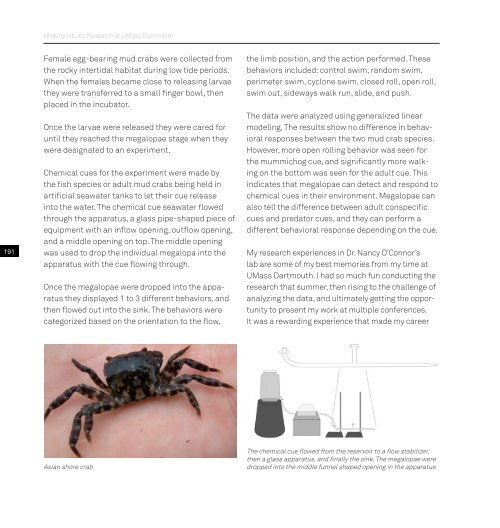Undergrad_Book_16-18_Pge_View_Print_no print marks_compressed
Create successful ePaper yourself
Turn your PDF publications into a flip-book with our unique Google optimized e-Paper software.
<strong>Undergrad</strong>uate Research at UMass Dartmouth<br />
191<br />
Female egg-bearing mud crabs were collected from<br />
the rocky intertidal habitat during low tide periods.<br />
When the females became close to releasing larvae<br />
they were transferred to a small finger bowl, then<br />
placed in the incubator.<br />
Once the larvae were released they were cared for<br />
until they reached the megalopae stage when they<br />
were designated to an experiment.<br />
Chemical cues for the experiment were made by<br />
the fish species or adult mud crabs being held in<br />
artificial seawater tanks to let their cue release<br />
into the water. The chemical cue seawater flowed<br />
through the apparatus, a glass pipe-shaped piece of<br />
equipment with an inflow opening, outflow opening,<br />
and a middle opening on top. The middle opening<br />
was used to drop the individual megalopa into the<br />
apparatus with the cue flowing through.<br />
Once the megalopae were dropped into the apparatus<br />
they displayed 1 to 3 different behaviors, and<br />
then flowed out into the sink. The behaviors were<br />
categorized based on the orientation to the flow,<br />
the limb position, and the action performed. These<br />
behaviors included: control swim, random swim,<br />
perimeter swim, cyclone swim, closed roll, open roll,<br />
swim out, sideways walk run, slide, and push.<br />
The data were analyzed using generalized linear<br />
modeling. The results show <strong>no</strong> difference in behavioral<br />
responses between the two mud crab species.<br />
However, more open rolling behavior was seen for<br />
the mummichog cue, and significantly more walking<br />
on the bottom was seen for the adult cue. This<br />
indicates that megalopae can detect and respond to<br />
chemical cues in their environment. Megalopae can<br />
also tell the difference between adult conspecific<br />
cues and predator cues, and they can perform a<br />
different behavioral response depending on the cue.<br />
My research experiences in Dr. Nancy O’Con<strong>no</strong>r’s<br />
lab are some of my best memories from my time at<br />
UMass Dartmouth. I had so much fun conducting the<br />
research that summer, then rising to the challenge of<br />
analyzing the data, and ultimately getting the opportunity<br />
to present my work at multiple conferences.<br />
It was a rewarding experience that made my career<br />
Asian shore crab<br />
The chemical cue flowed from the reservoir to a flow stabilizer,<br />
then a glass apparatus, and finally the sink. The megalopae were<br />
dropped into the middle funnel shaped opening in the apparatus



